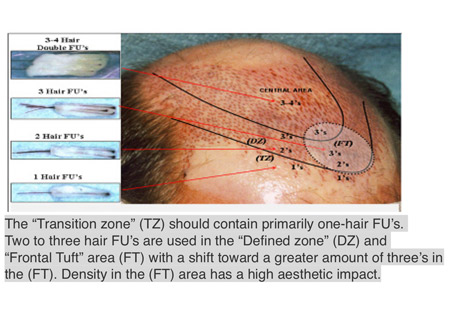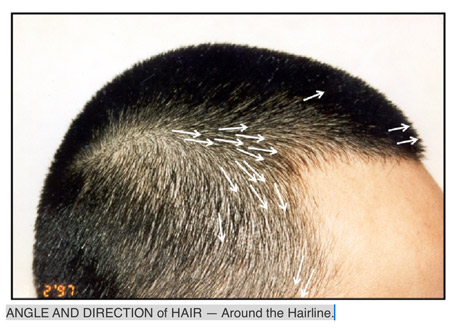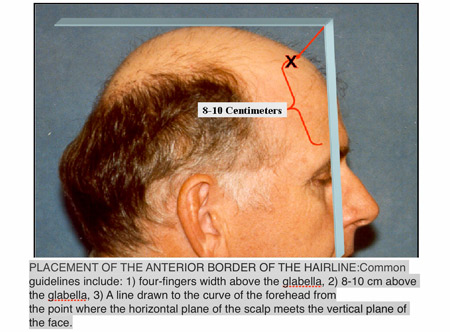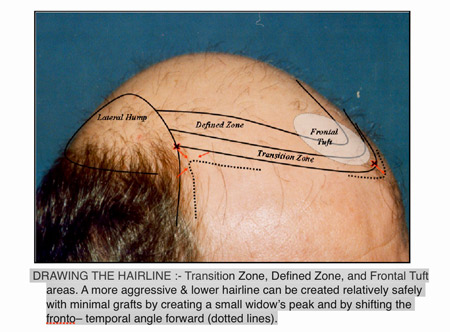Hairline designing
PRINCIPLES TO CREATE A NATURAL AND UNDETECTABLE HAIRLINE
Introduction
Creating a Natural Looking hairline is an important step for a successful Hair Transplant. Many of the promotional materials today, promise and advertise high-density hairlines. So the patient’s expectations have increased and he expects an undetectable hairline with highest density possible after one session. They will no longer tolerate a low-density hairline with an unaesthetic look.
We have better techniques now to create hairlines with smaller instruments and higher magnification. We have better understanding of the angle and the depth of the hair follicular units. With all this, we are able to achieve high-density hairline which appears natural with zigzag pattern and is undetectable.
This is basically possible by using smaller Follicular Units, FU’S, containing single hair to be used in the hair line.
This single hair FU’s are like the finer Paintbrushes used artistically to create a natural looking hairline.
Hairline is divided into a “Transition zone”, “Defined zone” and “Frontal Tuft Area”
Transition Zone
It is the first 0.5-1 cm of the hairline. It should be constructed to appear irregular and ill-defined. It is important to give micro irregularity to this zone. Multiple inverted -V patterns are drawn to give a zigzag character to it. The single grafts are implanted at these triangular shaped areas of inverted V’s and leaving intervening areas empty. If one looks at this hairline it should be seen as a “Serpentine Line” than as a linear line. The FU’s containing one hair should be used in this Transition Zone. If available, very fine single hair called ‘SENTINEL’ hair can be scattered in front of transition zone.
DEFINED ZONE
The defined zone is 2-3 cm wide and is immediate posterior to transition zone. In this area, the FU’s containing 2-3 hair are implanted.
FRONTAL TUFT AREA
This is the small oval area that lies in the central portion of the defined zone. This area should have the higher density then rest of the defined zone.

There should be minimum amount of epithelium on these FU’s to make them a tear drop shaped. Actually the FU’s should be broad at the base and minimal tissue at the top. The extra tissue around the lower part of the grafts saves the root (expended lower part of the hair) of the follicle prevented from dehydration, mechanical trauma and thus increases the survival. The technique of Dense Packing is defined as implanting 50-60 FU’s per cm2. A density more then this is not favourable for survival of all the grafts.
If there are not enough single hair FU’s, they can be made by dissecting from the existing two or three hair FU’s. This careful dissection of the hair from larger FU’s does not impair the vitality of the resulting single hair follicle. Our assistants are trained to separate 75-100 of the finest single hair grafts, to be used in the anterior most part of the hairline (TRANSITION ZONE). This adds to Surgeons ability to produce naturalness. The larger FU”S containing 2-3 hair are placed in defined zone, with greater proportion of FU’s containing three hair in the central oval zone (FRONTAL Tuft AREA)

PROPER "ANGLE" AND "DIRECTION" OF THE HAIR AT HAIR LINE
Angle is the degree of elevation of hair as it comes out of the scalp. Direction of hair refers to in which way the hair is pointing when it comes out of the scalp.
The hair at the frontal hairline is directed anteriorly and comes out of the scalp at 10-15 degree angles. Existing miniaturized hair can be seen to make out proper angle and direction of hair in that area. The hair at the temporal hairline is pointing inferiorly towards the ear and leaves the scalp at a very low angle (almost flat).
At FRONTO TEMPORAL angle we make a gradual change in the direction of newly transplanted hair from pointing anteriorly as in front hairline to pointing inferiorly as in temporal hairline. You can again take help of residual miniature hair at Temporal Frontal angle, that can act as a guidelines to match the transition in this area .

MAKING OF ANTERIOR BORDER OF HAIR LINE
The most important principle in hair line placement is "Don’t make the hairline too low"
Guiding factors to make the anterior border of hairline are as follows:
- 8-10cm from the glabella
- Four finger width from glabella
- Line drawn at the forehead where the horizontal plane of scalp meets the vertical plane.
The above points are only the guidelines and can be individualized based upon size of head, shape of head and degree of baldness.
In clients with Norwood Grade 5 and 6 we should raise the hairline from this desired point by 1-2 cm.
In such cases we can create a “Widow’s Peak” in the centre of hairline, to make the hairline look slightly lower without using too many grafts.

AN ARTISTIC TOUCH
All the above theoretical and practical points are as important as an artistic eye of a surgeon. No single hairline design can fit to all the cases. The surgeon should have an eye to create an aesthetically pleasing hairline that should be in harmony with your facial proportions.
This justice of a natural hairline designing can be best created by an Aesthetic Plastic Surgeon.
At Kyra Aesthetic Clinic, there is a team of three doctors headed by our chief hair transplant surgeon Dr. Vikas Gawri He is a board certified plastic surgeon with exhaustive experience in hair transplant and aesthetic surgery .He gives his key input in every case for designing an aesthetic hairline .
On the day of hair transplant Dr Vikas Gawri meets all his clients for a detailed discussion. He will listen to his clients patiently and understands their expectations. He may ask to see your old photographs to assess your hairline at a younger age. He will draw one or more patterns of hair line according to your case and discuss it with you .
Dr. Vikas Gawri is passionate in every case to design a hairline that will look natural and aesthetically pleasing according to your facial features..









